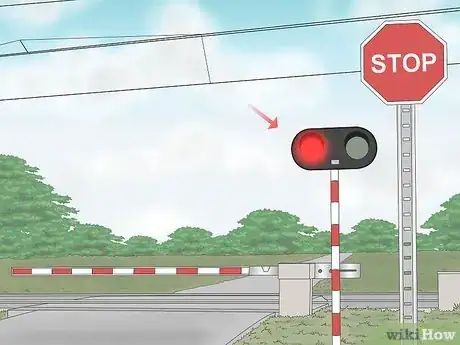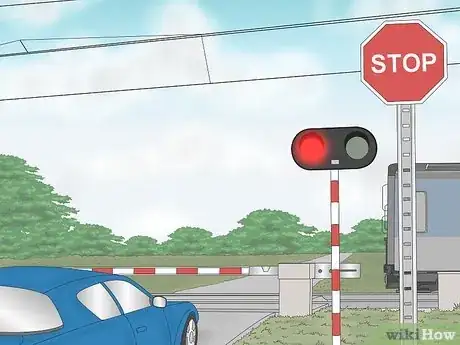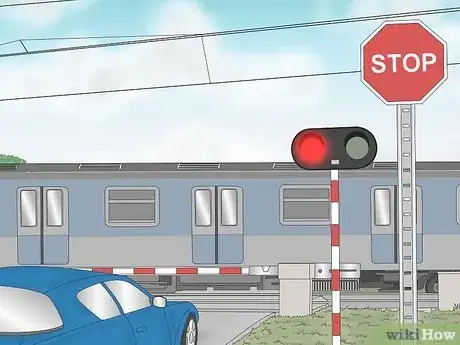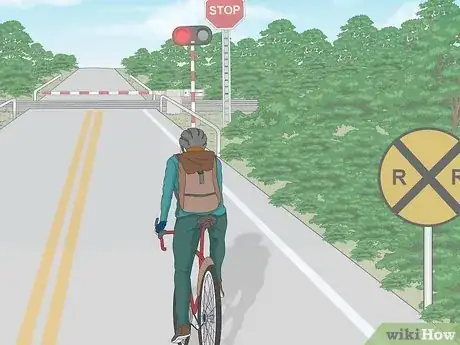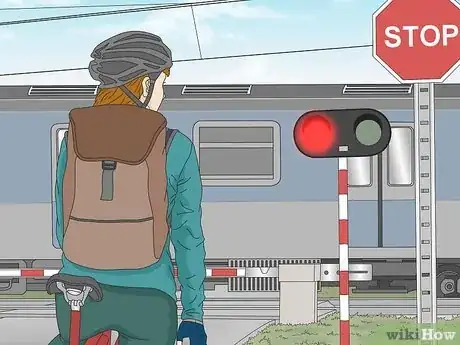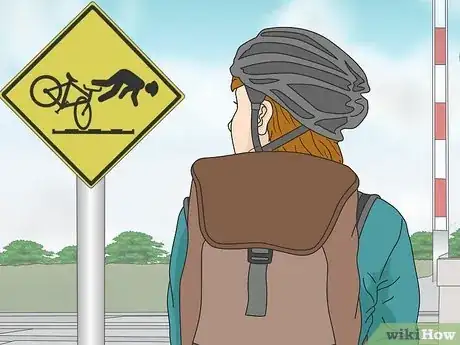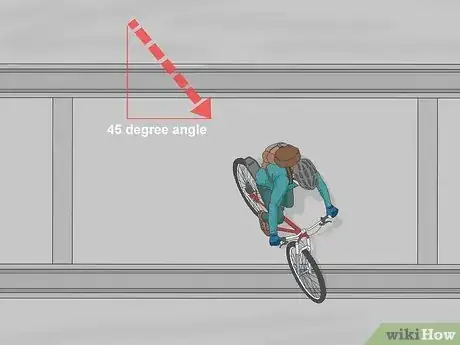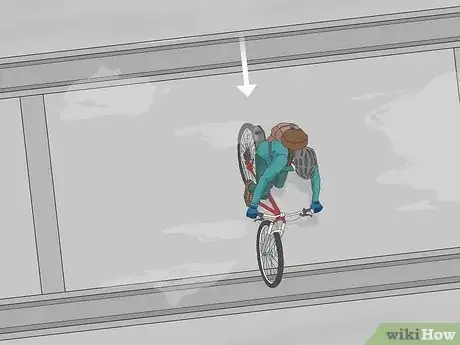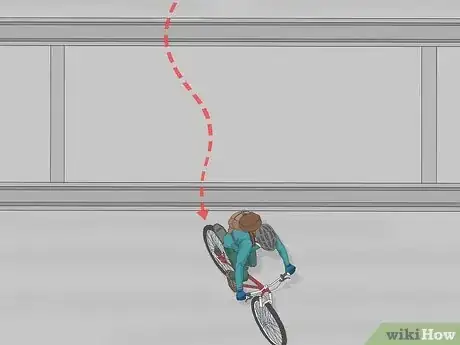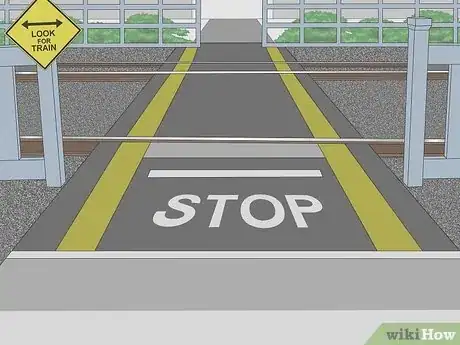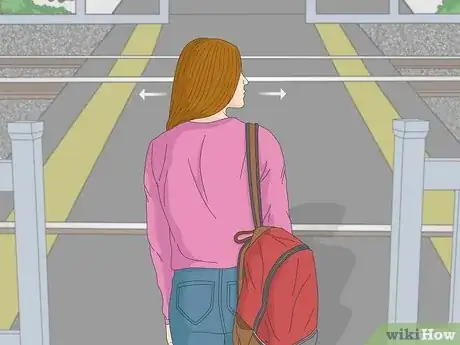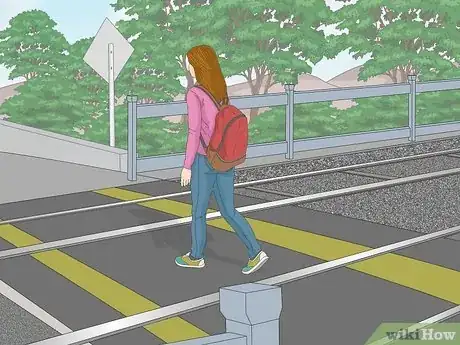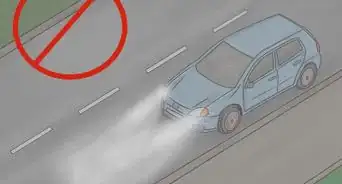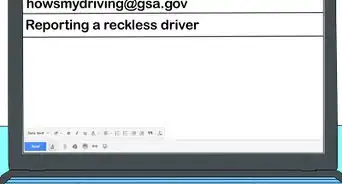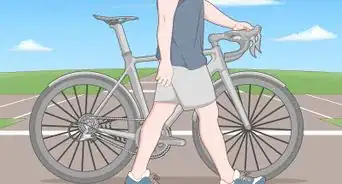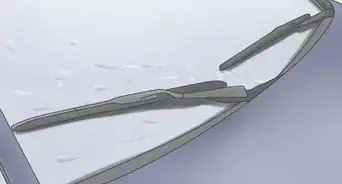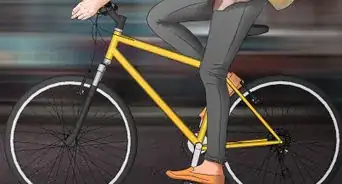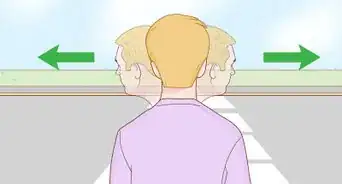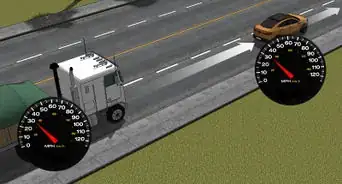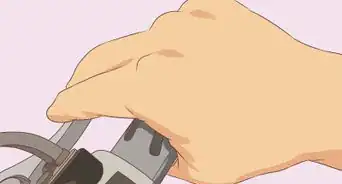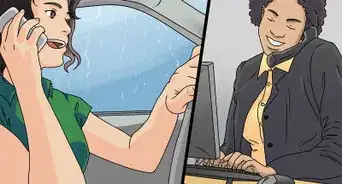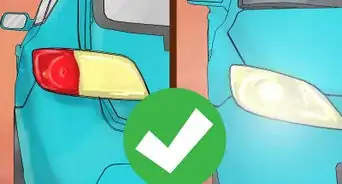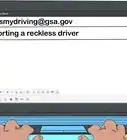This article was co-authored by wikiHow Staff. Our trained team of editors and researchers validate articles for accuracy and comprehensiveness. wikiHow's Content Management Team carefully monitors the work from our editorial staff to ensure that each article is backed by trusted research and meets our high quality standards.
This article has been viewed 60,135 times.
Learn more...
Almost everyone will have to cross railroad tracks at some point. Crossing railroad tracks may already be a common occurrence for you, and that is why it is important to know how to stay safe during the process. Crossing railroad tracks doesn’t have to be nerve-wracking if you are mindful of your surroundings. Understanding the laws and taking the right precautions are important whether you are crossing railroad tracks in a car, with a bike, or on foot.[1]
Steps
Driving a Car
-
1Approach with caution. There should be signs to warn you that you are nearing railroad tracks. Typically, it will be a circular sign with a black X and the letters RR, or a warning triangle with railroad tracks in the center of it. Once you get closer, you will probably see an X shaped sign that says Railroad Crossing. On the road, there will be another warning that looks similar to the circular sign. Slow your car down when approaching railroad tracks, even if there is no train in sight.[2]
- Look for signs designating the speed limit. You should not be going faster than 20mph.
- If there are no signs, you should be able to see the actual tracks ahead of you. Still approach slowly and be prepared to stop even if the gate is not down.
-
2Look for signs of an approaching train. There are several ways to know if the train is approaching. First, the gate may be down, and you might see the train passing by. If the train has not yet made it to the crossing, you will see flashing red lights signaling its approach. A person might be signaling the train’s approach, but that will not always be the case. You will also hear the train’s horn or bell before actually seeing the train. Look both ways down the track for an approaching train.
- You can slowly continue driving across the railroad tracks if you have checked and made absolutely sure that there is no train coming.
- Do not at any time stop in the middle of the tracks, even if a train is not approaching.
- Roll your windows down to listen for the train’s horn or bell. If music is playing in your car, pause it while listening for signs of an approaching train.
Advertisement -
3Stop your car if a train is approaching. If there are signs of an approaching train, you should stop your car even if the crossing gate has not yet gone down. Laws vary state by state about how far away you should stop from the railroad crossing. Usually, you should stop within 50 feet, but no closer than 15 feet from the nearest rail. Use your own discretion when deciding how close or far away to stop.
- If there is a stop sign, you must stop your car even if there is not a train approaching.
-
4Wait for the train to pass. The crossing gate should be down at this point, but do not cross even if the gate has not gone down. Your car should be at a complete stop at this point. Wait for the approaching train to cross the tracks you are waiting at. Continue waiting until the train is out of sight.[3]
-
5Make sure the train has passed. Although the train has passed, there might be another train approaching. Wait until the lights have stopped flashing and the crossing gate has gone up. You may begin driving again at this point. Don’t accelerate quickly from your stopping position. Slowly cross the tracks with caution in case something has fallen onto the tracks.
- Do not shift gears while crossing the tracks.
Riding a Bike
-
1Slow your bike when approaching railroad tracks. Look for signs of an approaching train. You should see signs, like a sign with an X and RR written on it. Check for flashing lights, a person signaling a train, and a horn or bell from an approaching train. Even if there are no signs of a train, slow your bike. Crossing tracks at full speed on a bike can be dangerous.[4]
- Make sure you are in the appropriate spot for a bike. The laws may state that bikers stay on the road, or on a specific bike path.
-
2Wait for the train to cross. If there is a train, you should stop your bike completely and wait. Do not try to race across the track before the train approaches. Either continue sitting on your bike, or get off your bike and stand next to it while holding the handle bars. Wait until the train has passed. Make sure another train is not coming. You are able to cross the tracks when the lights have stopped flashing, and the crossing gate has been lifted.[5]
-
3Know the risks of crossing the tracks on a bike. There are several risks you are taking when crossing railroad tracks on a bike. Knowing the risks before crossing the tracks will help prevent you from falling or becoming stuck on the tracks. The risks include falling into the gap next to the rail, falling in a gap near the tracks, and sliding on the tracks. The way you cross the tracks depends on what risks your perceive before crossing.[6]
-
4Go over the tracks at a 45 degree angle. Falling into the gap perpendicular to the rail happens because sometimes railroad crossings use coverings to make the railway smoother, but the coverings are made up of individual pieces that leave gaps. The gaps are often wider than a bike tire, which risks the bike tire falling into the gap. To avoid this, cross the tracks close to a 45 degree angle, instead of perpendicularly.
- Judge what is a 45 degree angle by using the outermost tracks as your basis for the bottom line of the angle.
-
5Cross the tracks in a straight line. Sliding happens on the tracks when they are slippery and/or wet. Avoid leaning the bike on slippery tracks. Instead, cross the tracks in a straight line. Try to go as slowly as possible when crossing.
-
6Cross the tracks safely. Do not try to line your bike up with the tracks. If your bike tires are narrow, do a slight S weave on the tracks, between 20 and 70 degrees. It is also an option to get off of your bike and walk it across the tracks.[7]
- You can “hop” across the raised tracks on your bike if you are an experienced bike rider. Do not attempt this if you do not know how to jump with a bike. It is dangerous and could lead to a crash if you are not experienced.[8]
Crossing as a Pedestrian
-
1Look for a pedestrian crossing. It is illegal to cross railroad tracks at any other location besides a designated pedestrian crossing. If you are not at a pedestrian crossing, walk at a safe distance away from the tracks until you locate one. There should be a sign and/or a ramp for pedestrians to safely cross.
- Crossing at an illegal location risks your safety, as well as a ticket or fine that can range from $500 or $6,000.
-
2Look for an approaching train. Stop at the pedestrian crossing even if there are no signs of an approaching train. Look both ways down the track to look for a train. Signs of a train are flashing lights, a lowered crossing gate, and bells or whistles. Wait at the designated pedestrian crossing if a train is coming. If not, slowly cross with caution if you are sure it is safe.
- Not every pedestrian crossing will have lights or bells to warn you. If the crossing does not, look both ways down the tracks and listen for a train.
- Stand at a safe distance away from the tracks. You should stand at least 10 feet away from the tracks.
-
3Cross when it is safe. Wait for the train to completely pass. Do not cross until you are sure that another train is not following. If there is a pedestrian crossing gate, wait until it is lifted to cross. There should be no more lights flashing or bells sounding. Look both ways once more before you cross.
- Do not listen to music while at a railroad crossing. Music can inhibit your ability to hear bells and/or whistles.
- Hundreds of people die every year on railway tracks. Do not play, sit, or walk directly on the tracks. A train takes at least a mile to stop, so it may not be able to stop in time if you are on the railway tracks.
- Do not try to hop aboard the passing train. You will risk serious injury or death.
Community Q&A
-
QuestionWhat should I do if I'm stuck on the track because both gates are down?
 Community AnswerIf this happens, immediately get out of the car and away from the tracks. At railroad crossings, there is often an emergency number posted beneath the warning lights. If this is not the case, dial 911.
Community AnswerIf this happens, immediately get out of the car and away from the tracks. At railroad crossings, there is often an emergency number posted beneath the warning lights. If this is not the case, dial 911. -
QuestionWhat should a trucker do when crossing rail road tracks on a dirt road?
 Community AnswerA trucker should follow the rules as usual. Stop if there is a stop sign. Exercise caution, look both ways, and cross slowly if there is no sign of a train. If there is a train approaching, wait for the flashing lights, lowered gate to raise, and bells and/or whistles to cross.
Community AnswerA trucker should follow the rules as usual. Stop if there is a stop sign. Exercise caution, look both ways, and cross slowly if there is no sign of a train. If there is a train approaching, wait for the flashing lights, lowered gate to raise, and bells and/or whistles to cross. -
QuestionWho gives out light rail crossing citations?
 Community AnswerThe law enforcement in your area, or a designated guard has the right to give out citations.
Community AnswerThe law enforcement in your area, or a designated guard has the right to give out citations.
Warnings
- A train can take up to a mile to stop when traveling at 60 mph (95 km/h). Don’t cross when a train is approaching, even if you think you have enough time.⧼thumbs_response⧽
- If your car stalls on a train track, get yourself and others out and move off the track immediately. Once you are safe, call the rail operators for help. If they say there is enough time, pull the vehicle clear. Always follow instructions given by rail operators.⧼thumbs_response⧽
- If a train passes but the lights are still on do not cross because another train is coming. This applies even if you think you have enough time.⧼thumbs_response⧽
- Do not rely on the crossing gates or the signal to determine whether it is safe to cross the tracks. If you hear a train, you must stop before the stop line.⧼thumbs_response⧽
References
- ↑ http://danger-ahead.railfan.net/reports/rep2000/us_xing_stats20000130.html
- ↑ https://driversed.com/driving-information/sharing-the-road-with-others/railroad-crossings.aspx
- ↑ http://www.mto.gov.on.ca/english/dandv/driver/handbook/section2.5.1.shtml
- ↑ https://janheine.wordpress.com/2012/03/07/crossing-tracks-safely/
- ↑ http://www.ilovebicycling.com/how-to-cross-railroad-tracks-on-a-bike/
- ↑ https://janheine.wordpress.com/2012/03/07/crossing-tracks-safely/
- ↑ https://janheine.wordpress.com/2012/03/07/crossing-tracks-safely/
- ↑ http://www.ilovebicycling.com/how-to-cross-railroad-tracks-on-a-bike/

